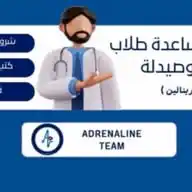
Inside the ICU🥼
3.5K subscribers
About Inside the ICU🥼
اتعملت القناة دى بنية أن يذهب المرء إلي قبره وهو فارغ وبنيه علم ينتفع به ( لاتنسونا من صالح دعاؤكم ) القناة هيتنشر عليها كل يوم معلومة جديدة لاى حد شغال فى المجال الطبي وبالأخص الرعاية المركزة منهم والطوارئ
Similar Channels
Swipe to see more
Posts

Acute exacerbation of trigeminal neuralgia can be excruciating and even lead to suicidality 🏳️

Methylene blue is used in vasoplegic shock when high-dose norepinephrine, vasopressin, and steroids fail to maintain MAP ≥ 65 mmHg. It works by inhibiting nitric oxide (NO)-mediated vasodilation, helping restore vascular tone. Indications for Methylene Blue in Septic Shock * Refractory Septic Shock (MAP < 65 mmHg despite high-dose vasopressors). * Vasoplegia (Distributive Shock) with High Cardiac Output, Low SVR. * Septic Shock with Profound Acidosis (Lactate > 4 mmol/L, pH < 7.2). * Post-cardiopulmonary bypass vasoplegia (if refractory to catecholamines). For the Infusion Protocol 1. Loading Dose (Slow IV Bolus Over 15-30 Minutes): • 1–2 mg/kg IV over 15–30 minutes • Dilution: Mix 50 mg (5 mL) of 1% methylene blue in 100 mL Normal Saline (NS) or D5W. • Infusion rate: Administer at 200–300 mL/hour to avoid hypotension. 2. Continuous Infusion (If Needed): • 0.25–0.5 mg/kg/hour IV infusion for 6–12 hours. • Dilution: Prepare 50 mg in 500 mL NS or D5W and run at 2–5 mL/hour (titrate based on response). For Monitoring & Precautions * Monitor BP every 5 minutes during bolus → Rapid infusion may cause paradoxical hypotension. * Check methemoglobin levels if prolonged infusion (>6 hrs). * Watch for rebound hypotension after stopping infusion. * Monitor renal & hepatic function (risk of toxicity in dysfunction).🏳️

Suggested indications for traumatic brain injury (TBI) seizure prophylaxis • GCS score of 10 or less • Immediate seizures • Linear or depressed skull fracture • Penetrating head injury • Subdural, epidural, or intracerebral hematoma • Cortical contusion • Age ≥ 65 years • Chronic alcoholism • Acute on chronic subdural hematoma requiring neurosurgical intervention 🏳️

Remember CVP and pulmonary artery occlusion pressure *SHOULD NEVER* be used to make decisions regarding fluid management Remeber normal CVP is close to ZERO 🏳️

The most common clinical picture of addison crisis is Unclear shock , so with unclear shock please give hydrocortisone 100mg IV. 🏳️

Any pt present with headache and any cranial N. findings should be potentially evaluated for cavernous sinus thrombosis 🏳️

Full dose parenteral anticoagulation MUST be started as soon as possible once cerebral venous sinus thrombosis is confirmed even if intracerebral hemorrhage is present 🏳️

The current Brain Trauma Foundation (BTF) guidelines suggest ICP monitoring for all TBI patients with a GCS score < 9 and pathological findings on cranial CT imaging. In unconscious patients with unremarkable cranial CT findings, ICP monitoring should still be considered if two of the following criteria are present: * age > 40 years * unilateral or bilateral motor deficits * systolic blood pressure < 90 mmHg 🏳️

Remember ! chest compressions in cardiac arrest are the priority intervention, unless the cardiac arrest is due to asphyxiation, drowning, or suffocation, which are the only circumstances in which ventilation must be provided before chest compressions 🏳️

Standard base deficit is a calculated value based on blood gas measurement as a gauge of metabolic acidosis. It approximates the amount of base that must be added to in vitro blood at 37°C and PaCO2 of 40 mm Hg to bring the pH to 7.4. Like lactate, elevated base deficit has been associated with mortality and poor clinical outcomes in shock states, especially in trauma. However, base deficit is affected by many factors. It can also be confounded by nonperfusion related conditions including sodium and chloride concentrations, hypoalbuminemia, respiration, exogenous sodium bicarbonate, or sodium chloride administration🏳️














